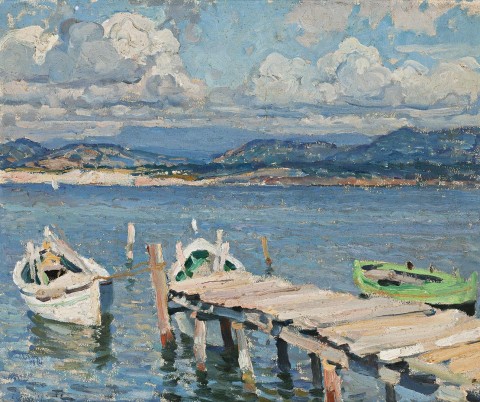(FISHING BOATS AND JETTY, LE BRUSC), c.1912 – 13
EMANUEL PHILLIPS FOX
oil on canvas
38.0 x 46.0 cm
signed lower left: E. Phillips Fox
Leonard Joel, Melbourne
Private collection, Melbourne
From their Paris apartment at 65 Boulevard Arago, Emanuel Phillips Fox and his wife Ethel Carrick often visited the French coasts, especially the fashionable beach resorts of Trouville and Royan, and later the south of France and the sunny waters of the Mediterranean. In September 1912, Fox had written to Hans Heysen: ‘… I hope to go South for October & look forward to getting some good work, in the neighbourhood of Arles …’.1 Later, during the spring of 1913 Fox and Carrick were in the south, at Le Brusc and Sanary, close by to Toulon. It was here, according to Carrick, that ‘Fox painted several brilliant seascapes’.2 The small fishing village of Le Brusc, described as a hamlet within the town of Six-Fours, lies west of Toulon, with Sanary and Bandol to the north. The Brusc lagoon, often dotted with colourful small fishing boats, separates Brusc from the open sea. It appealed to Fox as seen in Le Brusc, South of France, c.1912 – 13 (formerly in the D. R. Sheumack Collection, Zubans 424) and related paintings. The Argus reviewer of Fox’s Melbourne exhibition of June 1913 singled out these works for special mention: ‘A seascape that is very characteristic of the Mediterranean is met with in No. 64 [The Mediterranean], a very refreshing stretch of water with a rich mass of foreground rock. Others of the same class dealt with by impasto of pure colour are “The Coast at Le Brusc” (63), “The Shallows” (66), and “Towards Sanary, France”’. Catalogue number 60 in this exhibition is tantalisingly titled ‘Le Brusc, France’, eluding identification.
Fox had a special gift for painting water, the play of light on and through breaking waves seen at its best in Green Wave, Manly, c.1914 (National Gallery of Victoria, Melbourne). Another singular feature of his art is the handling of paint – thick, lively and enticing – appealing equally to sight and touch. It is one of the transformative features of (Fishing Boats and Jetty, Le Brusc), c.1912 – 13. The richly varied length and thickness of each brushstroke evokes allied associations of the sound of water lapping against boat and jetty, and the movement of the water itself. Beyond, the quiet grandeur of the hills and mountain ranges find harmony in the robust handling of the cumulous clouds above. All is enveloped in an aqueous atmosphere in which Fox and his fellow Impressionists delighted to excel.
Unlike the bright sunshine that sparkles in Cassis, South of France, c.1912 – 13 (Deutscher and Hackett, Sydney, 18 April 2018, lot 30) and so many others of these colourful seascapes, in (Fishing Boats and Jetty, Le Brusc) Fox effectively restricted his palette to capture the changing weather effects of a cloudy day. Areas of sunlight contrast with darker ones; the brighter wooden planks of the jetty and white boats leading the eye into the picture and its surrounds. The absence of figures allows for closer involvement of the viewer and the moment captured, as seen in other seascapes such as Rocks and Sea, c.1911 (The University of Melbourne Museum of Art Collection, Melbourne) and Towards Rose Bay, Sydney Harbour c.1913 – 14 (private collection).
1. Fox, E. P., letter to Hans Heysen, 27 September 1912, quoted in Zubans, R., E. Phillips Fox: His Life and Art, Miegunyah Press, Melbourne University Press, Melbourne, 1995., p. 183
2. Ethel Carrick manuscript notes for 1949 Fox retrospective exhibition, Fox file, Art Gallery of New South Wales, quoted in Eagle, M., The Oil Paintings of E. Phillips Fox in the National Gallery of Australia, Canberra, 1997, pp. 77, 80, footnote 86
DAVID THOMAS
